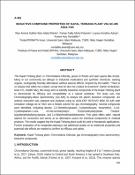Options
Bioactive Compound Properties of Kapal Terbang Plant Via Gc-Ms Analysis
Date Issued
2024
Author(s)
Wan Amirul Solihin Wan Abdul Rahim
Universiti Sains Islam Malaysia
Farhan Fadly Mohd Pahamin
Universiti Sains Islam Malaysia
Liyana Amalina Adnan
Universiti Sains Islam Malaysia
Abstract
The Kapal Terbang plant, or Chromolaena Odorata, grows in forests and open spaces like shrubs. Many in our community are allergic to industrial medications and synthetic chemicals, seeking organic, ecologically friendly alternatives without adverse effects. Inspired by the Hadith, "There is no disease that Allah has created, except that He also has created its treatment" (Sahih Al-Bukhari, book #71, Hadith 582), this study aims to identify bioactive compounds in the Kapal Terbang plant to demonstrate its efficacy and compatibility as a natural substitute. The study uses Gas Chromatography-Mass Spectrometry (GC-MS) to analyse the plant's bioactive compounds. An acetone extraction was prepared and analysed using an AGILENT INTUVO 9000 GC-MS with ionisation voltage set at 70eV and a Restek column for gas chromatography. Several compounds were identified, including decane, 2,2-Dimethoxybutane, Cyclotrisiloxane, hexamethyl-, 2,4,6-Cycloheptatrien-1-one, 3,5-bis-trimethylsilyl-, Tris(trimethylsilyl)ester, Tris(tert-butyldimethylsilyloxy)arsane, and 1,4-Bis(trimethylsilyl)benzene. This plant offers safer, natural options for consumers and serves as an alternative source for chemical components in medical products. The results suggest that the Kapal Terbang plant could be used in therapeutic applications. Further evaluation of its metabolite pathways and additional studies on its medicinal properties and potential side effects are needed to confirm its efficacy and safety.
File(s)
Loading...
Name
Bioactive Compound Properties of Kapal Terbang Plant Via Gc-Ms Analysis.pdf
Size
278.98 KB
Format
Adobe PDF
Checksum
(MD5):f10f19a6d740d6ae26c2e46406df3ebc